7 Ways to Grow Your Business with Content Marketing

I have been in the business of content creation for the past 10 years. My first startup, a motorcycle publication (BikeAdvice.in) succeeded because of content marketing. My current startup, a performance marketing company, also gets its best customers and clients from content marketing.
In this article, I want to talk about how you can grow your business using content marketing. We will discuss about the different types of content and the marketing strategies you can use to promote the content.
Let’s first understand why “Content” is very important.
It might look like a bold claim, but it is true: “If the world cannot live without the internet, the internet cannot live without content.”
Content is the source of all attention, online or offline. If you think about all the different channels of digital marketing, you will be able to realize that content is the foundation for every channel.
- People search for content in search engines.
- People share content on social media, without which platforms like Facebook will not exist.
- We send content via email, without which email marketing wouldn’t exist.
Even if you think about pre-internet marketing channels like TV, Radio, Newspapers, and Magazines – they got the attention of the audience because of the content they created.
Content is the Source of all Human Attention
A lot of people relate content marketing & SEO to “free marketing”. And sometimes it looks like the opposite of paid advertising. Paid advertising cannot exist without content.
Let’s have a small thought experiment… if you have an unlimited budget for paid advertising, and if there is no content out there in the world, where will you put your ads on?
People do not tune into any channel to see and consume promotional messages. They tune in for useful content, news, and entertainment.
People are attracted to a channel for its content. Paid advertising “rents” attention from other content pieces with interruptive advertising.
That doesn’t mean paid advertising is necessarily bad. It is part of the media ecosystem. Paid advertising revenue helps the platforms pay for maintaining and improving the platform.
The digital marketing world is not very different from the traditional marketing world. Digital platforms have made it easier for anyone to create and publish content, and that was not something possible a few decades back. Only publishing houses were able to publish content using a content team.
Google thrives on webmasters like you and me creating content. Facebook thrives on content created by people and broadcasting to their circle of friends. And both Google and Facebook capitalize on this attention to make revenue from ads.
For paid advertisers, it gives an easy way to get the attention of prospective customers by leveraging the attention that other content creators have earned. The platforms cannot improve and spend money on hosting content without paid advertising. So both paid ads and content have to balance themselves, for all parties involved.
It is the content that earned the attention in the first place. Paid advertising cannot exist without useful content. However, the quality of the attention that content earns is always better than what paid advertising can earn. This leads us to think about Inbound and Outbound attention…
Inbound Attention Vs. Outbound Attention
If I don’t have anything interesting to say, you wouldn’t pay attention to me. If I am being useful and entertaining, you will pay attention to me and I would have earned it.
Now if I do not have the capability to capture your attention and if I pay someone else to get that attention for me – it is very much like, you are in conversation with a friend at a party and I pay that friend of yours to introduce me to you.
In this case, you didn’t come to me… I came to you, via your friend who you are paying attention to. I will always feel like a loser because I would be one!
You wouldn’t respect me if I didn’t earn your attention.
Inbound attention is the highest quality of attention you can get from a prospect when you are in the business of selling something. And useful content is what earns the inbound attention.
Outbound attention’s quality will always be less than inbound. Display ads and other similar types of interruptive ads are purely outbound attention-seeking. It’s like paying someone to introduce you to the other person at a party.
How to Get Inbound Attention with Content
Content marketing, where you are creating useful content and also distributing it efficiently, is pure inbound attention. The quality of the audience that you will attract with content is always going to be better than the quality that you attract with paid advertising.
The data also backs it up. The quality & the revenue potential of leads that I get from my blog is way higher than what I get from Facebook Ads or other interruptive advertising channels.
The reason why content marketing is still the best way to market your products or services is that you are getting attention with useful content directly from your end customer. You are earning attention, with your content assets, instead of renting it from people who have already created the content.
When I own my content, I am not trying to interrupt you while you are paying attention to someone else. Advertising my free digital marketing course on my blog obviously would have a way higher conversion rate than advertising it on someone else’s blog.
So now that you have understood why content is important, and is the source of all human attention, let’s look at the various ways you can use content to grow your business.
1. Blogging
Blogging has remained as the best content marketing method for any business for a very long time, as long as the internet has existed.
Blogging is also easy to get started. It is a content marketing method with the lowest barrier of entry.
I am getting attention from my potential customers, right now, because of this blog post.
If you are reading this right now, you know that I am good with content marketing and digital marketing, which increases my authority and trust in me.
And you may become a paid customer for one of my products 🙂 (Will you?)
Blogging also gives a platform for a long, in-depth, meaningful conversation. There are other content channels that are equally good as blogging, but as many people thought, blogging has not gone out of fashion. Nor will it ever die in the future.
Written text is the foundation of human civilization and it can communicate thoughts from one human to another human in a way no other medium can, ever.
Many people thought that video blogging, microblogging, and social media will kill blogging. And people have been saying that blogging will be dead for a long time now.
If you are reading this line right now, blogging is far from being dead.
I am almost 1,000 words into the blog post and I haven’t lost your attention yet. Kudos to my writing skills!
My blog has got more than 100,000 new visitors in the last 90 days.
And I also pixel them on Facebook and Google Audiences. That way I can run retargeted ads to my audience when they are not on my blog and spending time at other platforms.

Blogging is also great for getting search traffic. Search engines have experimented with video thumbnails and other snippets on search engines but they have gotten back to plain text results.
It is a clear indication that people prefer content pages on websites over other types of media.
Out of the 100k views I’ve got for my blog in the last 90 days, more than 50% have come from organic searches. That’s free traffic for which I haven’t paid a penny (except hosting costs).
And the best part is that I will continue to get traffic in the future for a long time for the content that I have created already. This article can be of value to someone even after a few years.

One of the reasons that text-based content is still going strong is that it is easy to skim through a blog post and see the structure of the entire content in one glance.
It is impossible to do something like that with a video where unless you watch the entire video, you will not be able to get an idea of what’s inside the video.
But that doesn’t mean videos are out of fashion. This leads us to the 2nd best content marketing method…
2. Videos
Creating videos and posting them on a video platform like YouTube is also a very good way to earn the attention of prospective customers. Videos build trust because it shows the human behind the content.
What has worked for me is posting 3-5 minute videos covering topics in a simple and easy-to-digest way.
I am not an aggressive YouTube yet, but I have posted a few hundred videos on my YouTube channel and the channel has got almost 30,000 subscribers already.
In the last 90 days alone I’ve earned 143,000+ views for videos hosted on my channel.

It is also easy to get views for a YouTube video using Google Video Ads.
With video discovery ads on Google Ads, one can drive discoverability to the video for as low as half a cent per view. I have published a video tutorial on how to promote YouTube videos using Google ads which you should definitely take a look at.
Right now YouTube is the primary platform for hosting videos online for free. However, you can also look at platforms like Wistia and Vimeo where you can host your own videos. If you are having gated or premium content, it is best to use one of these platforms to host the video.
I have all my premium course videos hosted at learn.digitaldeepak.com which is a learning management system. The videos are on Amazon’s servers and are delivered by Teachable’s video player.
Also, video content doesn’t always need to be hosted on your own platform.
I delivered a TEDx talk at the beginning of 2018 and it has got 200k+ views so far.
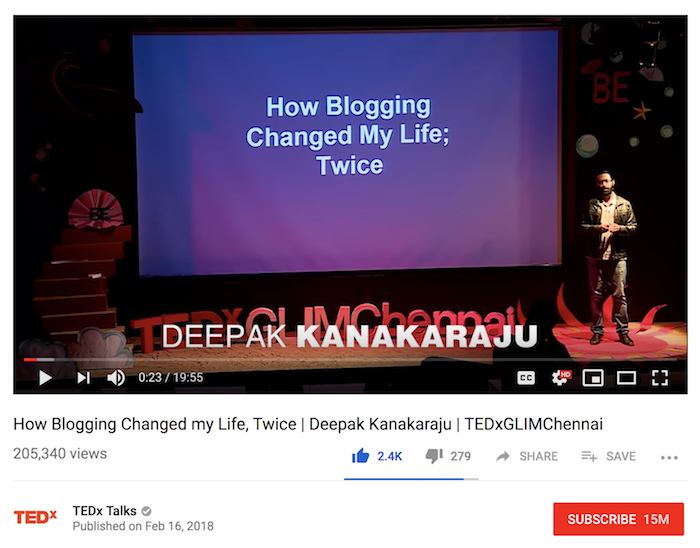
It helps me get my brand out there, which leads more people to my personal blog, which leads to more subscribers, customers, and clients.
The conversion ratios of all my ads go up because more people have heard about me somewhere or the other. Top-of-the-funnel branding is one of the most overlooked conversion rate optimization strategies.
If people have heard about you before… it helps you improve ad conversion rates, CTRs on search result pages, engagement on your blog, email open rates, and buyer conversion rates.
But both blogging and video have their challenges. Too many people are doing it and it is difficult to cut through the clutter.
That leads us to explore content marketing opportunities that have a higher barrier of entry. Books!
3. eBooks and Books
eBooks have more perceived value than blog posts. Printed books have even more perceived value than ebooks. I have published more than 10 ebooks for my subscribers and followers so far and every ebook has outperformed my expectations.
The first ebook that I published was also hosted on Amazon called “How to Get Your Dream Digital Marketing Job.”
The ebook also has got Amazing reviews on Amazon. This helps with an instant positive perception and authority for my personal brand.
I would consider this ebook as the launch pad for my blog and personal brand. It all started with this ebook.
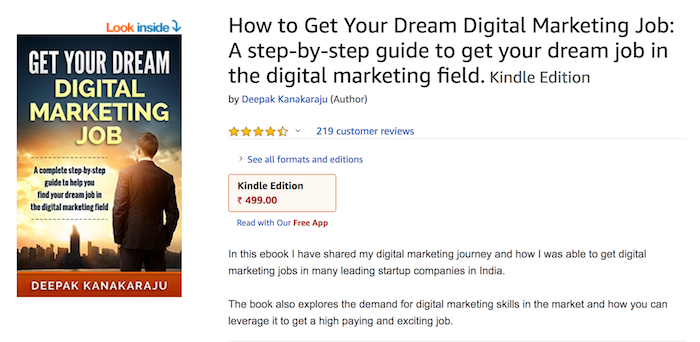
Ebooks can be published as PDFs or on Amazon Kindle.
I would recommend publishing it on the Amazon Kindle platform because your ebook gets hosted on Amazon.com and other TLDs of Amazon. It is great for SEO.
Amazon’s domain has a high domain authority and your content will easily rank on the search engines.

You can see from the above result, that Amazon is ranking No.1 for the keyword above my blog because of their domain authority.
Amazon is also running ads on Google from their ad budget for driving more transactions in their platform, which indirectly helps me get free paid advertising because I have put up the ebook on sale at Amazon.
Print books are also great for content marketing. Print books can help you with offline content marketing and acts as heavy business card.
If you go to a sales meeting with a prospective client or for an interview, you will be able to give them a copy of your book to them and it would always be with them. No one throws away a book. And it will be on their desk or shelf for a long time and they keep getting reminders of your personal brand.
I have written an extensive article on how to self publish a book and you should definitely read it if you want to take books seriously.
And the best part about books is there is no sales tax on them! (In most of countries)
4. User Generated Content
Creating a forum, community or group and letting users create content is one great way to generate high-quality engaging content, fast.
User-generated content not only gets high-quality attention, it also helps with creating a strong social proof and a fan base among your audience. When less engaged followers see the social activity from stronger fans, they are also influenced to become your fans.
Apart from good quality content, social proof is also required to reinforce the attention that you get for your content – because not everyone will go through all your content in an in-depth manner initially in the interest of time. They will not be 100% bought in to start with. Social proof helps them know that your content is really good and they will “invest” their time in going through your content in-depth. And when they do, they will become your life-long followers and fans.
So now that we know social engagement and community content are important, where to start?
There are different platforms on which user-generated content can be delivered. Private forums used to have a lot of traction a while back but right now, Facebook Groups is outperforming every other platform.
In the past 3 years, I’ve built the largest digital marketing learning group on Facebook.
It's called “Learn Digital Marketing” and it has more than 100,000 members now. Most of my posts get 500+ likes and 100+ comments. The activity is so high that I spend almost 1-2 hours a day on this group, interacting with my audience and getting better insights into what they need.

If you have more than 50% of the members in the group as active members, it is a well-maintained group.
According to Facebook, we have 60,000+ members who are active on the group right now. And to keep the number of active members up, the admins and the moderators of the group have to constantly engage the group.
AMAs (Ask me anything sessions) are one of the best ways to engage the group and bring a new audience into the group. AMAs are usually done with live videos but they can be done based on text comments as well.
Here’s one AMA we’ve announced recently. This post, by one of our team members who manage the group, announcing the AMA by Varsha has already got 100+ comments within 14 hours of posting.
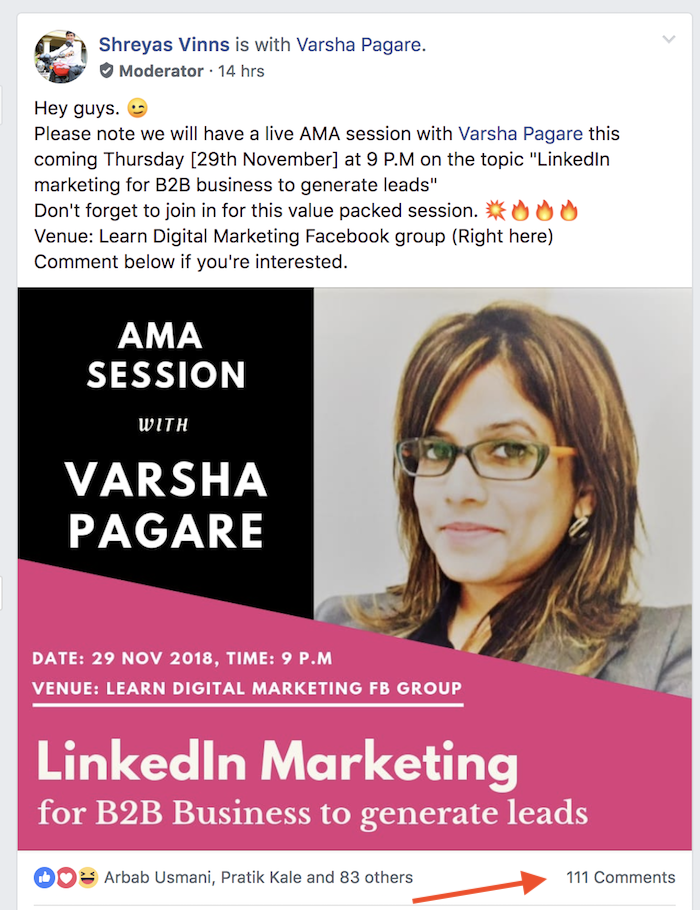
Constant moderation, deleting spam and hateful posts, and reviewing the profile of new members joining the group are also very important to make sure that the group remains useful and members are not bored with spammy posts.
In this group, I’ve India as the top country and Bangalore, Hyderabad, Delhi, and Mumbai as the top cities for the group.
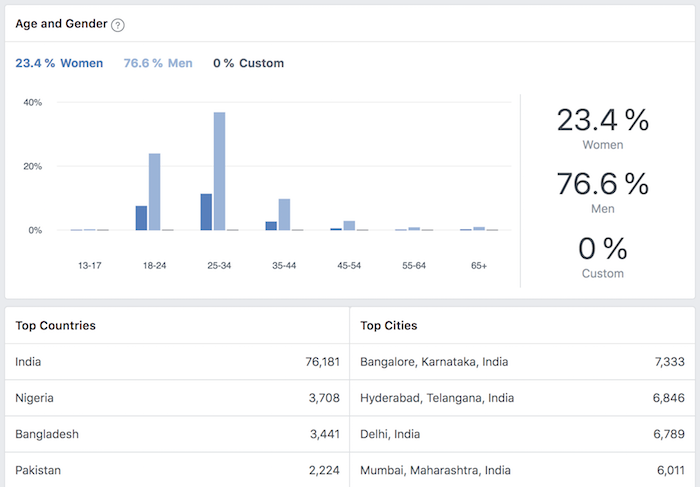
It is also a good idea to meet the members of the group offline. I do offline meet-ups from time to time.
I collect a small token fee of 200 to 300 rupees and meet the group members at a co-working space in the city. Here’s one photo from a recent meet-up I did at Kolkata.
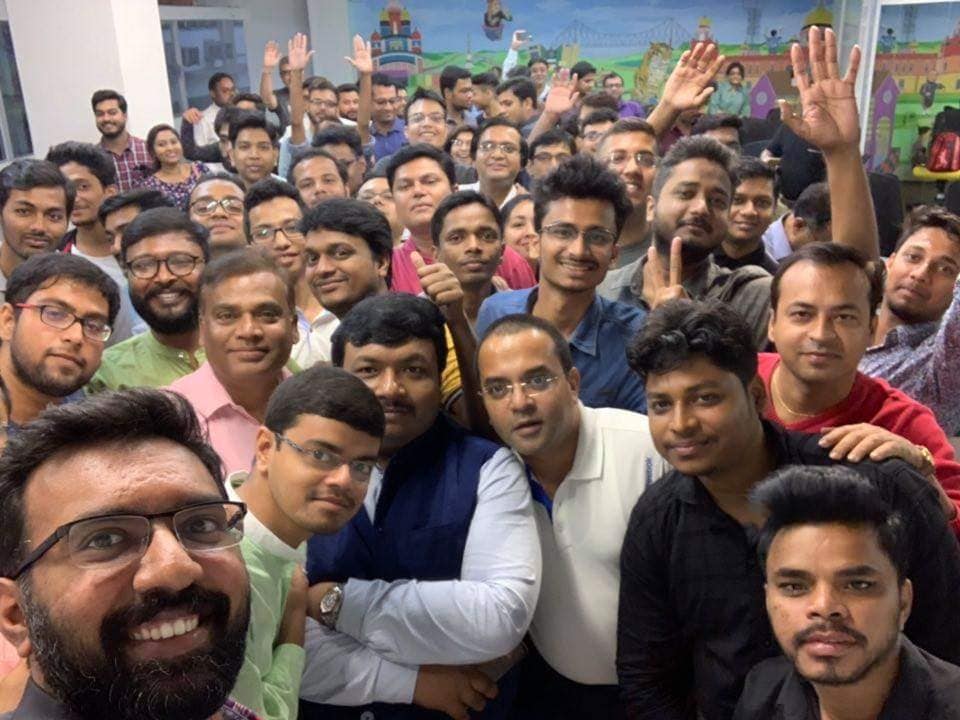
Such activities strengthen the group because the members who have met offline would now know the person behind the name and profile picture online. It increases interaction with other members and also with the people who run the group.
Groups are also a great platform for doing surveys, research, and getting more insights from your audience.
Here’s a recent poll I ran to find out what method people prefer to make money.

I could find out that most people wanted to be affiliate marketers followed by online trainers and public speakers.
Understanding such needs from the target market helps me create products that suit my audience without a problem. I don’t even have to put too much effort into selling the product because the product fits their requirements to start with.
“The aim of marketing is to know and understand the customer so well the product or service fits him and sells itself.” – Peter Drucker
So groups and communities are something that cannot be ignored. It can be a great platform for market research, dynamic real-time content, and building social proof for your brand.
5. Email Newsletters
I love email marketing as much as I love blogging. But the No.1 question that most people ask me when it comes to email marketing is – why would I create content within emails when I publish them on a blog and share it on social media?
The most important thing with Email is that you can set up a content delivery automation that provides value over time, sequentially.
Blog posts that I publish on this blog are not sequential content. It is good quality content, published from time to time, like this article. However, it is not in sequence.
Email content need not necessarily be heavy. As long it is sequential, conversational, and value-driven, it will perform great.
Email newsletters are better for engagement and brand recall, than brand discovery.
One great example of a well-performing newsletter is my 100-day Blogging Tips newsletter.

Anyone can sign up for my blogging tips from www.LearnBlogging.com, and they would get one blogging tip a day.
I have set up the sequential emails at ActiveCampaign and I am getting pretty good open rates on the emails.
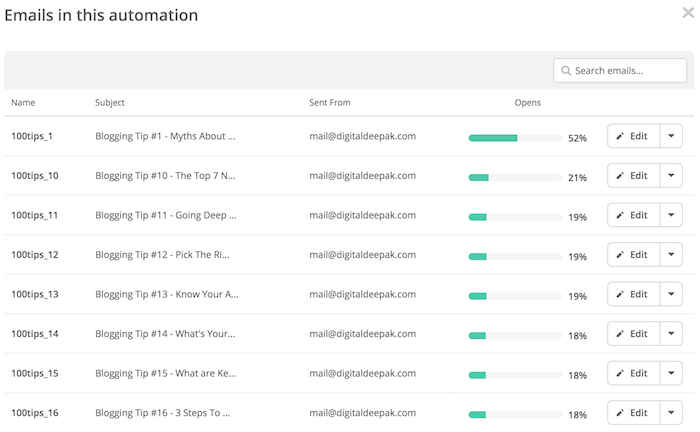
Content within emails is not available on a public platform and it has a feel of exclusivity to it. Subscribers regard it as premium content.
Email newsletters also have a 1:1 communication impact because most personal communication happens via emails including with friends and family.
Engaging people on emails over time is also great for conversions. For sales emails, offers, and product launch sequences, email marketing outperforms any other marketing channel. Social media can spread awareness, but email marketing brings in conversions and revenue.
However, no brand can leverage email marketing only by sending sales/promotional emails. If all the subscribers get is a promotion in their inbox, they will not engage.
A good balance of value-based emails along with promotional content from time to time is the best way to get the maximum out of email marketing.
6. Podcasts
Audio podcasts are another great way to create content. I like podcasts because it helps me create long-form casual content that videos and text-based content channels cannot help.
Writing blog posts takes a lot of effort. There is editing and reviewing involved in it. Videos cannot be made without proper lighting and cannot be published without editing.
Podcasts help make long-form content that is casual and deep. Interviews, thoughts, business advice, book reviews and more can perfectly fit into podcasts.
I recently started a podcast series called StartupFuel.com and it has got a great response.
Even though the content is hosted on YouTube, it is mostly audio content. And the audio is also available on platforms like SoundCloud and iTunes.
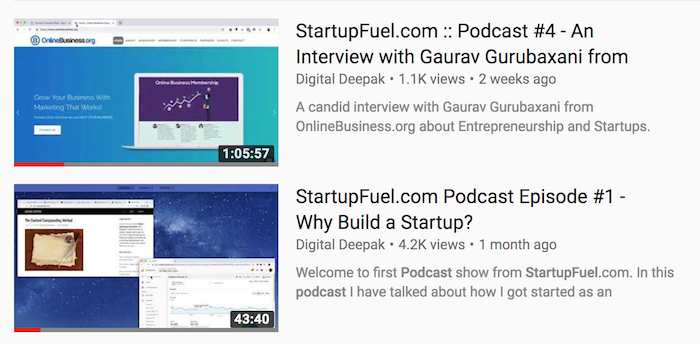
The first podcast episode of StartupFuel.com has already received 5000+ views and the comments are very encouraging.
Podcasts help you create deep meaningful content by removing the headache of polishing and editing the content. Not everyone listens to long-form podcasts, but your best followers and customers will.
7. Free Tools
I had to think twice before adding this as a section in content marketing. This is somewhat of a grey area but let me include it in any way because this is too powerful of a method to be ignored.
Companies who develop premium tools for marketers can be SaaS companies and they cannot be included here. They are startups in their own sense and it has nothing to do with content marketing. They do their own content marketing to get customers for their products.
What we are talking about is free tools. Just like a free piece of content like a free course or an ebook attracts traffic leads, access to free tools can attract traffic and leads. Free tools can include but are not limited to Calculators, report generators, and optin tools.
A while back I launched this free optin tool called OptinChat and it quickly became viral among the blogging community.
Every blogger who used the widget naturally linked back to the home page of OptinChat and we got 100s of new registrations per day at its peak.
These were free leads and the growth rate was much faster than giving away free content.

Neil Patel has followed a similar strategy recently where he acquired Uber Suggest, a premium keyword research tool for digital marketers, and gave it away for free on his blog. This led to a lot of backlinks and traffic to his blog.
This type of marketing is also called side project marketing. The project itself doesn’t bring in the revenue, and more often than not it costs money to develop and host the product. But the free tool becomes the top of the funnel for your main product or service, attracting prospects and customers into your marketing funnel.
One of the tools that I am working on for the near future is a “Proposal Generator” for consultants and agencies.
Anyone who wants to send a digital marketing proposal to a new prospective client can use this tool to generate beautiful proposals to impress clients.
So how would I get back the investment in the creation of this tool? I will promote my flagship Agency Course that will be launched in 2019.
Anyone who uses the Proposal Generator will also be a potential student for my course. And I will be getting highly targeted leads. Only people who are having an agency or going to start an agency will be using this tool, and it will spread very fast using word-of-mouth.
WordPress plugins, stand-alone tools, templates, calculators, apps, and so on will fit into the category of “Free Tools”.
Another free tool that has performed very well as a lead generation tool for me is the Digital Deepak app on the Play Store.
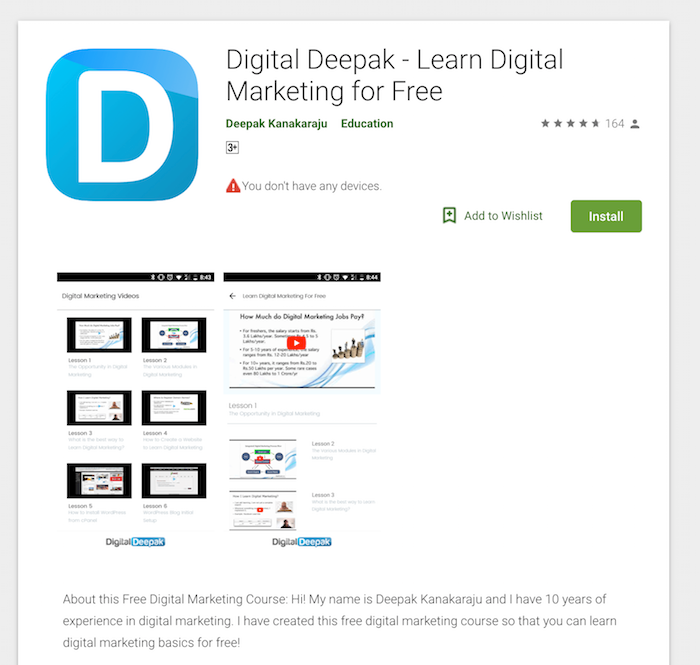
The app contains 25 free digital marketing video tutorials inside it.
So the free content is packaged into an app and lets people access the content via the app on their mobile phones.
People who like the content will keep the app on their phone and there is a huge branding value just like books. When they see the app multiple times on their phone, it is free brand re-targeting.
Brand recall value is very high with apps because apps are not easy to make and the barrier of entry is high. It cost me around $1000 to develop this app. Not every blogger can do this, but if you can do it, then you will be rewarded.
Final Words
I hope this article helped you understand how content marketing can help you drive brand awareness, engagement, and conversion. The best part about content marketing is that sales can be generated without being pushy.
A few years back, I developed a process called Integrated Digital Marketing which has been the foundational strategy that I’ve used for most of the startups that I worked and consulted with.
Integrated Digital Marketing also puts content as the central foundation and all the other digital marketing methods are built around it.
You can read in-depth about Integrated Digital Marketing here.
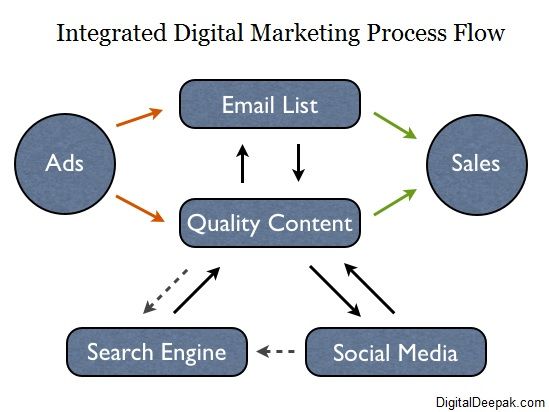
When you use other paid marketing methods with content, it amplifies your content.
I do not advertise my premium digital marketing courses directly, instead, I advertise my free digital marketing course with 25 videos on Google Ads and Facebook Ads.
Facebook Ads is pure outbound attention. However, search engine ads, though not purely content is still not entirely outbound. Search engine ads are somewhere in the middle. I would call them semi-inbound.
With search ads, you are advertising only to the people who are looking for you, but you are able to get attention even if you are not the best result among the organic results being displayed in the search engines.
And with Google Ads paying attention to quality scores and making sure the landing pages are not misleading, users trust Google. And you can still end up getting high-quality traffic from search engine ads – almost as good as the content.
I am promoting content that builds engagement and trust. And I use this relationship I’ve developed with my prospects to sell my premium digital marketing courses, without being pushy.
Content marketing lubricates the process of a prospect going from brand discovery, all the way to a customer becoming a brand advocate.
Without content, your business will have too much friction converting prospects into friends and friends into customers. Content marketing helps you sell, without looking like you are selling something.
With content marketing, you are helping your prospects discover great products and services that would help them solve their problems and move forward in their life.
I hope this article helped you see the power of content marketing in a new light.
So what content marketing methods you will be using to grow your business? I would like to hear from you!
Cheers,
Deepak Kanakaraju
P.S. There is another category I thought of including here: Offline Events, Conferences & Meet-ups. Though they are content, it is not content that can replicate itself. A conversation between people is not content. If they are recorded and published online, then they would fall under the video category.
I am constantly trying to refine an exhaustive list of all types of content and publishing mediums. You can check the list here on my sheet.